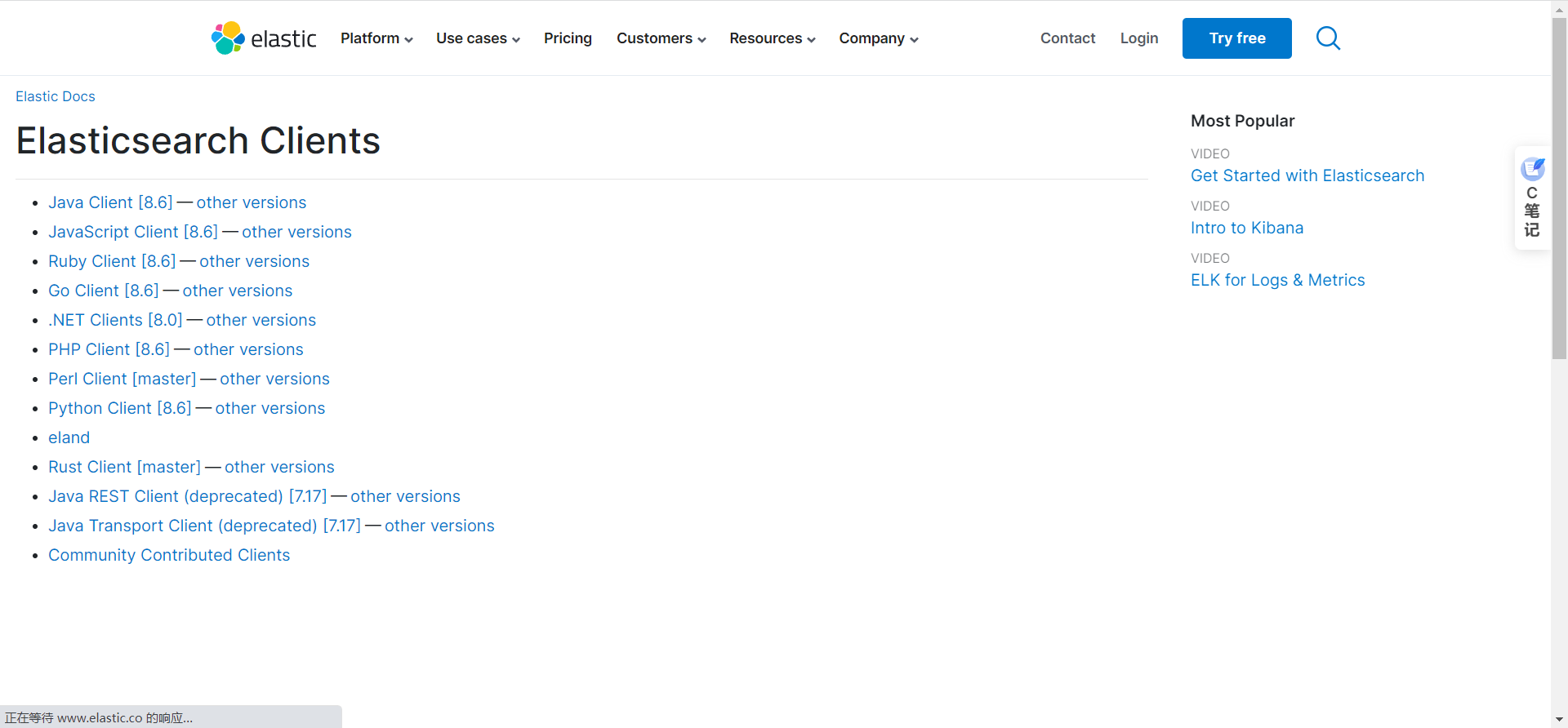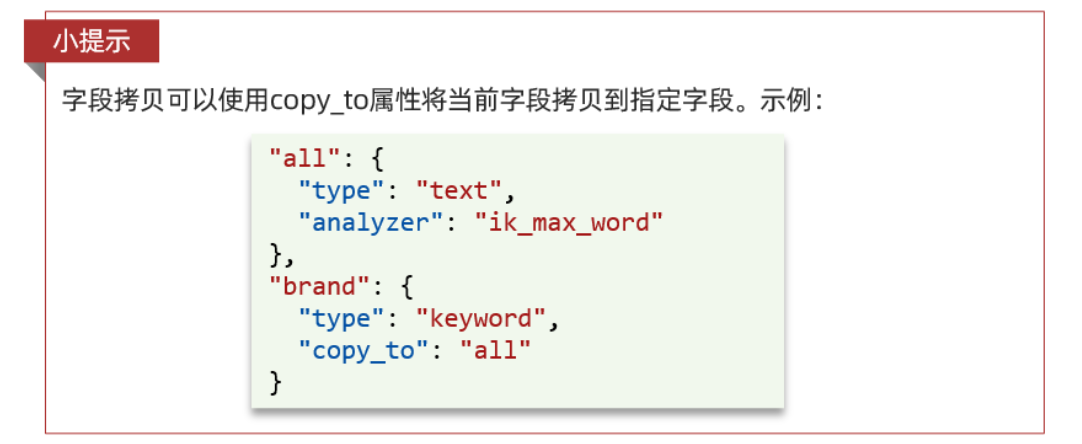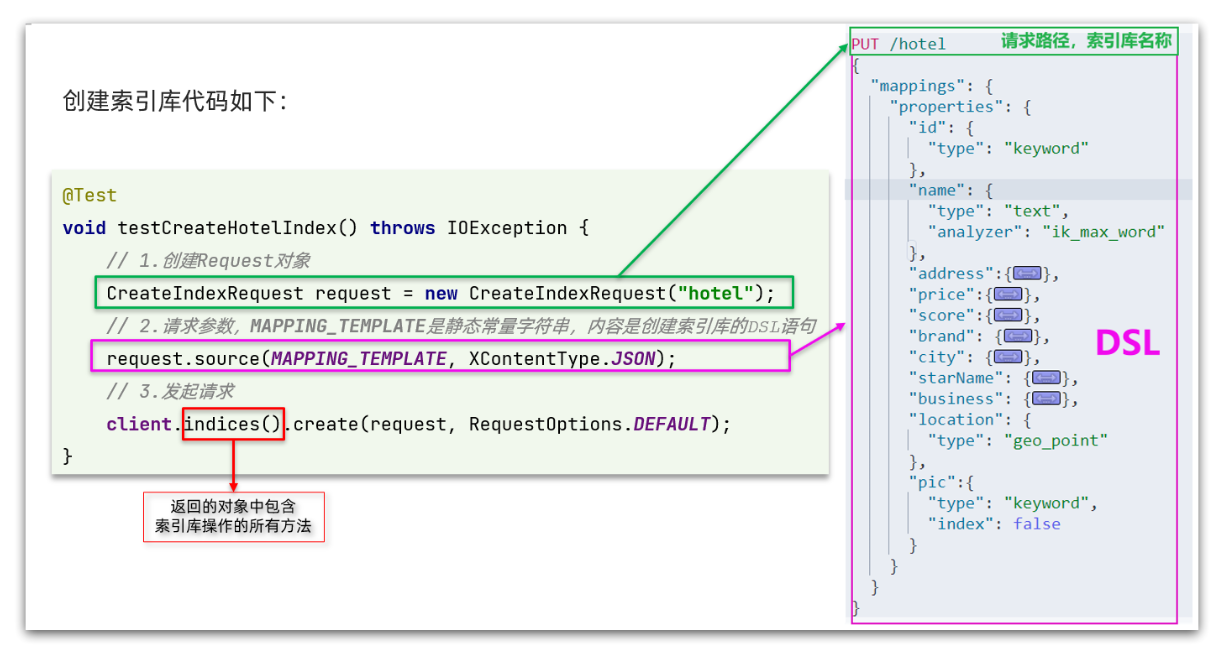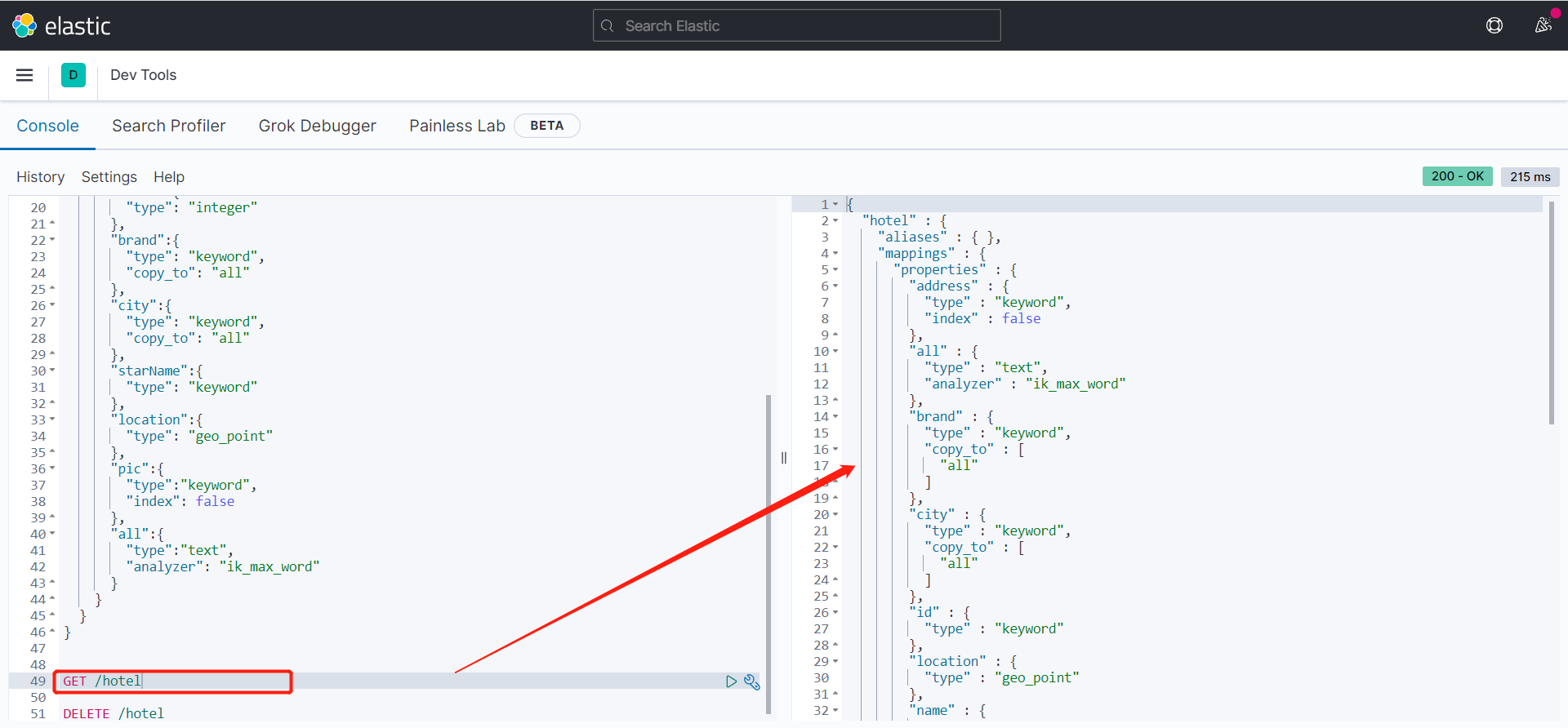- Python赋能AI数据分析开启人工智能新时代
- 【opencv】示例-neural
- 基于springboot大学生兼职平台管理系统(完整源码+数据库)
- 使用vite+vue+flask实现一个简单的前后端交互效果
- 爬虫——python爬取京东商品用户评价
- Spring AI 使用本地 Ollama Embeddings
- The error occurred while executing
- Rust面试宝典第7题:单词接龙
- Node Version Manager(nvm):轻松管理 Node
- 【docker】Docker打包SpringBoot镜像
- Cause: org.springframework.jdbc.Can
- Nginx使用教程
- 十五分钟带你学会 Electron
- Spingboot3详解(全网最详细,新建springboot项目并详
- Rust面试宝典第6题:快乐数
- springboot实现黑名单和白名单功能
- MySQL中EXISTS谓词作用及原理
- 二手交易|校园二手交易小程序|基于微信小程序的闲置物品交易平台设计与实
- AI时代的Web开发:让Web开发更轻松
- 大数据 DataX-Web 详细安装教程
- 23、Lua 学习笔记之一(初阶话题)
- SpringBoot的 ResponseEntity类讲解(具体讲解返
- 【Docker系列】容器访问宿主机的Mysql
- MongoDB【四】查询与聚合框架
- 【Go设置国内代理】
- HCIA | WLAN二层旁挂组网实验
- MySQL- 创建可以远程访问的root账户
- Spring Boot最经典的20道面试题,你都会了吗?
- 今日推荐库:@microsoftfetch-event-source
- uniapp实现事件级防抖
文章目录
- ⛄引言
- 一、RestAPI
- ⛅导入数据
- ⏰mapping映射分析
- ⚡初始化RestClient
- 二、索引库操作
- ⌚创建索引库
- ✒️删除索引库
- ⚡判断索引库是否存在
- ⛵小结
⛄引言
本文参考黑马 分布式Elastic search
Elasticsearch是一款非常强大的开源搜索引擎,具备非常多强大功能,可以帮助我们从海量数据中快速找到需要的内容
一、RestAPI
ES官方提供了各种不同语言的客户端,用来操作ES。这些客户端的本质就是组装DSL语句,通过http请求发送给ES。官方文档地址:https://www.elastic.co/guide/en/elasticsearch/client/index.html

⛅导入数据
数据结构如下
CREATE TABLE `tb_hotel` ( `id` bigint(20) NOT NULL COMMENT '酒店id', `name` varchar(255) NOT NULL COMMENT '酒店名称;例:7天酒店', `address` varchar(255) NOT NULL COMMENT '酒店地址;例:航头路', `price` int(10) NOT NULL COMMENT '酒店价格;例:329', `score` int(2) NOT NULL COMMENT '酒店评分;例:45,就是4.5分', `brand` varchar(32) NOT NULL COMMENT '酒店品牌;例:如家', `city` varchar(32) NOT NULL COMMENT '所在城市;例:上海', `star_name` varchar(16) DEFAULT NULL COMMENT '酒店星级,从低到高分别是:1星到5星,1钻到5钻', `business` varchar(255) DEFAULT NULL COMMENT '商圈;例:虹桥', `latitude` varchar(32) NOT NULL COMMENT '纬度;例:31.2497', `longitude` varchar(32) NOT NULL COMMENT '经度;例:120.3925', `pic` varchar(255) DEFAULT NULL COMMENT '酒店图片;例:/img/1.jpg', PRIMARY KEY (`id`) ) ENGINE=InnoDB DEFAULT CHARSET=utf8mb4;数据我放到网盘了,大家可自行获取
⏰mapping映射分析
创建索引库,最关键的是mapping映射,而mapping映射要考虑的信息包括:
- 字段名
- 字段数据类型
- 是否参与搜索
- 是否需要分词
- 如果分词,分词器是什么?
其中:
- 字段名、字段数据类型,可以参考数据表结构的名称和类型
- 是否参与搜索要分析业务来判断,例如图片地址,文件地址 就无需参与搜索
- 是否分词呢要看内容,内容如果是一个整体就无需分词,反之则要分词
- 分词器,我们可以统一使用 ik_max_word ik分词器最大分词
以下是酒店的索引库结构
PUT /hotel { "mappings": { "properties": { "id": { "type": "keyword" }, "name":{ "type": "text", "analyzer": "ik_max_word", "copy_to": "all" }, "address":{ "type": "keyword", "index": false }, "price":{ "type": "integer" }, "score":{ "type": "integer" }, "brand":{ "type": "keyword", "copy_to": "all" }, "city":{ "type": "keyword", "copy_to": "all" }, "starName":{ "type": "keyword" }, "business":{ "type": "keyword" }, "location":{ "type": "geo_point" }, "pic":{ "type": "keyword", "index": false }, "all":{ "type": "text", "analyzer": "ik_max_word" } } } }几个特殊字段说明:
- location:地理坐标,里面包含精度、纬度
- all:一个组合字段,其目的是将多字段的值 利用copy_to合并,提供给用户搜索
地理坐标 说明:

copy_to说明:
=

⚡初始化RestClient
在 Elasticsearch 提供的API中,与 Elasticsearch 一切交互都封装在一个名为RestHighLevelClient的类中,必须先完成这个对象的初始化,建立与 Elasticsearch 的连接。
大概分为3步
引入ES的RestHighLevelClient依赖
org.elasticsearch.client elasticsearch-rest-high-level-client SpringBoot 的默认ES版本为7.6.2,覆盖默认的ES版本
1.8 7.12.1 初始化RestHighLevelClient
RestHighLevelClient client = new RestHighLevelClient(RestClient.builder( HttpHost.create("http://ip地址:9200") ));为了测试方便,我们新建单元测试进行初始化
import org.apache.http.HttpHost; import org.elasticsearch.client.RestHighLevelClient; import org.junit.jupiter.api.AfterEach; import org.junit.jupiter.api.BeforeEach; import org.junit.jupiter.api.Test; public class HoteTest { private RestHighLevelClient client; @BeforeEach void setUp() { this.client = new RestHighLevelClient(RestClient.builder( HttpHost.create("http://192.168.150.101:9200") )); } @AfterEach void tearDown() throws IOException { this.client.close(); } }二、索引库操作
⌚创建索引库
创建索引库的API如下:

代码分为三步:
- 创建Request对象。因为是创建索引库的操作,因此Request是CreateIndexRequest。
- 添加请求参数,其实就是DSL的JSON参数部分。因为json字符串很长,这里是定义了静态字符串常量MAPPING_TEMPLATE,让代码看起来更加优雅。
- 发送请求,client.indices()方法的返回值是IndicesClient类型,封装了所有与索引库操作有关的方法。
创建一个类,定义mapping映射的JSON字符串常量:
public class HotelEnum { public static final String MAPPING_TEMPLATE = "{\n" + " \"mappings\": {\n" + " \"properties\": {\n" + " \"id\": {\n" + " \"type\": \"keyword\"\n" + " },\n" + " \"name\":{\n" + " \"type\": \"text\",\n" + " \"analyzer\": \"ik_max_word\",\n" + " \"copy_to\": \"all\"\n" + " },\n" + " \"address\":{\n" + " \"type\": \"keyword\",\n" + " \"index\": false\n" + " },\n" + " \"price\":{\n" + " \"type\": \"integer\"\n" + " },\n" + " \"score\":{\n" + " \"type\": \"integer\"\n" + " },\n" + " \"brand\":{\n" + " \"type\": \"keyword\",\n" + " \"copy_to\": \"all\"\n" + " },\n" + " \"city\":{\n" + " \"type\": \"keyword\",\n" + " \"copy_to\": \"all\"\n" + " },\n" + " \"starName\":{\n" + " \"type\": \"keyword\"\n" + " },\n" + " \"business\":{\n" + " \"type\": \"keyword\"\n" + " },\n" + " \"location\":{\n" + " \"type\": \"geo_point\"\n" + " },\n" + " \"pic\":{\n" + " \"type\": \"keyword\",\n" + " \"index\": false\n" + " },\n" + " \"all\":{\n" + " \"type\": \"text\",\n" + " \"analyzer\": \"ik_max_word\"\n" + " }\n" + " }\n" + " }\n" + "}"; }在hotel-demo中的HotelIndexTest测试类中,编写单元测试,实现创建索引:
import org.elasticsearch.client.indices.CreateIndexRequest; @Test void createHotelIndex() throws IOException { // 1.创建Request对象 CreateIndexRequest request = new CreateIndexRequest("hotel"); // 2.准备请求的参数:DSL语句 request.source(MAPPING_TEMPLATE, XContentType.JSON); // 3.发送请求 restHighLevelClient.indices().create(request, RequestOptions.DEFAULT); }✒️删除索引库
删除索引库的DSL语句非常简单:
DELETE /hotel
与创建索引库相比:
- 请求方式从PUT变为DELTE
- 请求路径不变
- 无请求参数
所以代码的差异,注意体现在Request对象上。依然是三步走:
- 创建Request对象。这次是DeleteIndexRequest对象
- 准备参数。这里是无参
- 发送请求。改用delete方法
在hotel-demo中的HotelIndexTest测试类中,编写单元测试,实现删除索引:
import org.elasticsearch.action.admin.indices.delete.DeleteIndexRequest; @Test void testDeleteHotelIndex() throws IOException { // 1.创建Request对象 DeleteIndexRequest request = new DeleteIndexRequest("hotel"); // 2.发送请求 restHighLevelClient.indices().delete(request, RequestOptions.DEFAULT); }⚡判断索引库是否存在
判断索引库是否存在,本质就是查询,对应的DSL是:
GET /hotel
DSL查看如下

因此与删除的Java代码流程是类似的。依然是三步走:
- 创建Request对象。这次是GetIndexRequest对象
- 准备参数。这里是无参
- 发送请求。改用exists方法
import org.elasticsearch.client.indices.GetIndexRequest; @Test void testExistsHotelIndex() throws IOException { // 1.创建Request对象 GetIndexRequest request = new GetIndexRequest("hotel"); // 2.发送请求 boolean exists = restHighLevelClient.indices().exists(request, RequestOptions.DEFAULT); // 3.输出 System.out.println(exists ? "索引库已经存在!" : "索引库不存在!"); }小结
JavaRestClient操作elasticsearch的流程基本类似。核心是client.indices()方法来获取索引库的操作对象。
索引库操作的基本步骤:
- 初始化RestHighLevelClient
- 创建XxxIndexRequest。XXX是Create、Get、Delete
- 准备DSL( Create时需要,其它是无参)
- 发送请求。调用RestHighLevelClient#indices().xxx()方法,xxx是create、exists、delete
⛵小结
以上就是【Bug 终结者】对 微服务 分布式搜索引擎 Elastic Search RestAPI 的简单介绍,ES搜索引擎无疑是最优秀的分布式搜索引擎,使用它,可大大提高项目的灵活、高效性! 技术改变世界!!!
如果这篇【文章】有帮助到你,希望可以给【Bug 终结者】点个赞👍,创作不易,如果有对【后端技术】、【前端领域】感兴趣的小可爱,也欢迎关注❤️❤️❤️ 【Bug 终结者】❤️❤️❤️,我将会给你带来巨大的【收获与惊喜】💝💝💝!














